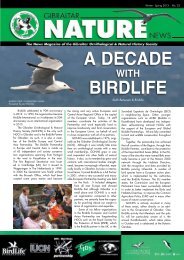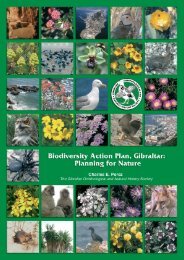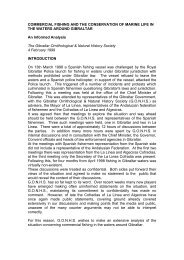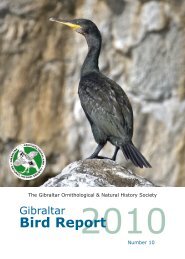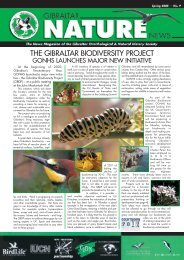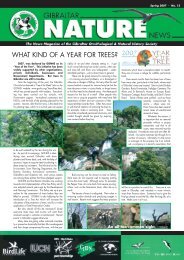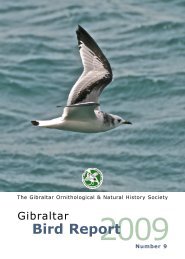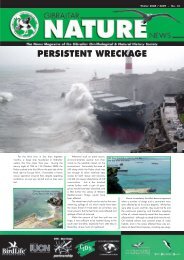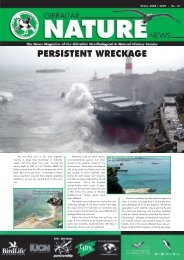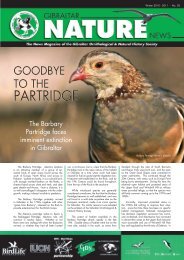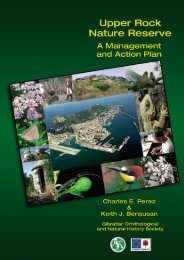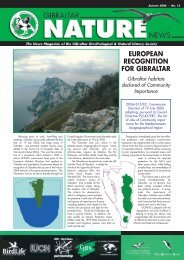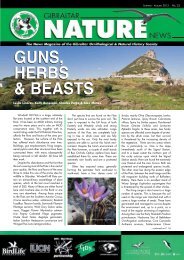No.15 - Gibraltar Ornithological & Natural History Society
No.15 - Gibraltar Ornithological & Natural History Society
No.15 - Gibraltar Ornithological & Natural History Society
You also want an ePaper? Increase the reach of your titles
YUMPU automatically turns print PDFs into web optimized ePapers that Google loves.
The east side of <strong>Gibraltar</strong> is due to change<br />
drastically in coming years. The major East Side<br />
Development, once known as "Sovereign Bay"<br />
has received outline planning permission following<br />
acceptance by the Development &<br />
Planning Commission, of the Environmental<br />
Impact Assessment of the site. This was an<br />
extensive document that highlighted a number<br />
of environmental concerns, both short and long<br />
term.<br />
Concerns included a reduction in quality of<br />
the bathing waters in some sections of beach,<br />
the need to analyse the material in the fill as<br />
toxicity could not be ascertained during the<br />
study, and impact of dredging on coastal processes.<br />
In its own representations on the matter, the<br />
Catalan Bay community provided a great deal<br />
of evidence referring to the degradation of the<br />
marine habitat in the area. The EIA had, for<br />
example, dismissed the effect on the sandy seabed<br />
communities because it has already deteriorated<br />
due to conch raking. The Catalan Bay<br />
representations state that this is not an argument,<br />
as the habitat could recover with time if<br />
protected. Indeed some of the points raised<br />
regarding the deterioration of the marine habitat<br />
are alarming. The Eastside development will<br />
do nothing to improve this.<br />
East side sand<br />
slopes with lotus<br />
arenarius<br />
The visual impact of the development will<br />
be huge. Advocates of the scheme hail this as<br />
adding an attractive feature to the area. Most<br />
people fear the adverse effect on the natural<br />
look of <strong>Gibraltar</strong>'s north-eastern sea-cliff landscape,<br />
which will become distorted for ever.<br />
At least, one would have thought, most of<br />
the coastline to the south of this development,<br />
would retain most of its natural character,<br />
retaining its historical, wildlife and landscape<br />
value. Not so. In reviving an old scheme which<br />
most had wanted to forget, ABCO, a <strong>Gibraltar</strong>based<br />
company, applied for planning permission<br />
to build on the sand slopes above Sandy<br />
Bay.<br />
This area is adjacent to a protected Site of<br />
Community Interest, listed by the European<br />
Union. It is a green site with an interesting<br />
natural community. Moreover, it allows a clear<br />
view from the main road of the impressive<br />
Great Sand Slopes and the cliffs above, providing<br />
one of the few views of almost completely<br />
natural landscape in <strong>Gibraltar</strong>.<br />
The construction will block much of this<br />
EASTERN PROMISE<br />
One of the plans for six luxury villas<br />
view, and this feeling of wilderness, to be<br />
replaced with an impacting development of six<br />
luxury villas. Thus six people will replace what is<br />
currently there and, judging by the trends elsewhere<br />
in <strong>Gibraltar</strong>, the owners will be absent for<br />
most of the year.<br />
An environmental statement was prepared<br />
for the developer by a UK-based firm,<br />
Environmental Gain Ltd. The same firm also<br />
prepared a statement for the Government which<br />
requested this as an Appropriate Assessment,<br />
which was required as the site is adjacent to a<br />
Community site. GONHS considered that neither<br />
document was thorough enough nor that all<br />
environmental aspects were addressed. Outline<br />
planning permission was nevertheless given.<br />
The site is partly covered with invasives, but<br />
on the other hand holds a wide range of plant<br />
species and is important for molluscs and reptiles,<br />
with Bedriaga's Skink, a species of European<br />
importance being found there.<br />
Representations have been made to the<br />
pertinent authorities to have the permission<br />
reversed, and Nature News will report on<br />
progress.<br />
An on-line petition urging the <strong>Gibraltar</strong><br />
Government to halt the project can be accessed<br />
on http://www.thepetitionsite.com/1/stop-bothworlds-villas.<br />
This development cannot be considered in<br />
isolation. Together with the larger Eastside<br />
project, another project by ABCO to the south of<br />
Sandy Bay, and plans adjacent to the nearby<br />
Caleta Hotel, <strong>Gibraltar</strong>'s eastern coastline could<br />
suffer irrevocable damage and the natural character<br />
of the area obliterated.<br />
GONHS's Leslie Linares on<br />
Mediterranean Steps - overlooking the<br />
site of the proposed villas<br />
NOTES & NEWS<br />
SILENE TOMENTOSA RE-INTRODUCTION<br />
In November 2006 members of the Cliffs and<br />
Caves Section of GONHS helped in planting out<br />
eight young Silene tomentosa on the cliffs above<br />
Mediterranean Steps. This was reported in Issue<br />
No. 13 of Nature News. This last spring, two of<br />
these plants were seen flowering for the first time.<br />
The plants looked healthy and well established on<br />
the cliff, and hopefully seeds from these plants will<br />
germinate elsewhere around the site.<br />
GiBrALtAr cAmPion on<br />
the eAst side sAnd sLoPes<br />
Every year, a botanical survey is carried out of the<br />
restored sand slopes on the East Side. This year,<br />
during the survey carried out on 24th April, an<br />
amazing discovery was made: a <strong>Gibraltar</strong> campion,<br />
Silene tomentosa, growing on the sand slopes.<br />
The plant is a mature one, some four or five years<br />
old, and is in extremely good condition, as seen on<br />
the photograph. The last time that a plant of this<br />
species was seen growing in the wild was in 1994,<br />
14 years ago!<br />
What makes the find especially astonishing is the<br />
fact that it is growing on sand and in a completely<br />
exposed situation. In all the floras from the 19th<br />
century and later, this species is always described<br />
as growing on limestone cliffs and outcrops. In fact,<br />
all recent sightings of this very rare, endemic species<br />
have been precisely on limestone outcrops. The<br />
discovery of this plant in this habitat turns on its<br />
head all previous notions about the species.<br />
Some 20 seeds were collected from this plant during<br />
a seed-collecting visit to the slopes in July.<br />
senior heritAGe AWArd 2008<br />
GONHS Botanical Section Co-ordinator Leslie<br />
Linares has to be congratulated for obtaining this<br />
year’s Senior Heritage Award from the <strong>Gibraltar</strong><br />
Heritage Trust. This award is in recognition of his<br />
dedicated researching and recording of <strong>Gibraltar</strong>’s<br />
flora over the last 30 years. It is noteworthy that this<br />
award recognises that our natural heritage is an<br />
important and integral part of <strong>Gibraltar</strong>’s<br />
Heritage.<br />
GIBRALTAR NATURE NEWS<br />
3



